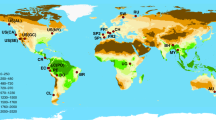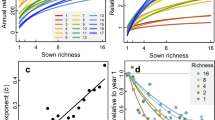Abstract
Deciphering the mechanisms that link biodiversity with ecosystem functions is critical to understanding the consequences of changes in biodiversity. The hypothesis that complementarity and selection effects drive relationships between biodiversity and ecosystem functions is well accepted, and an approach to statistically untangle the relative importance of these effects has been widely applied. In contrast, empirical demonstrations of the biological mechanisms that underlie these relationships remain rare. Here, on the basis of a field experiment with young trees, we provide evidence that one form of complementarity in plant communities—complementarity among crowns in canopy space—is a mechanism, related to light interception and use, that links biodiversity with ecosystem productivity. Stem biomass overyielding increased sharply in mixtures with greater crown complementarity. Inherent differences among species in crown architecture led to greater crown complementarity in functionally diverse species mixtures. Intraspecific variation, specifically neighbourhood-driven plasticity in crowns, further modified spatial complementarity and strengthened the positive relationship with overyielding—crown plasticity and inherent interspecific differences contributed near equally in explaining patterns of overyielding. We posit that crown complementarity is an important mechanism that may contribute to diversity-enhanced productivity in forests.
This is a preview of subscription content, access via your institution
Access options
Access Nature and 54 other Nature Portfolio journals
Get Nature+, our best-value online-access subscription
$29.99 / 30 days
cancel any time
Subscribe to this journal
Receive 12 digital issues and online access to articles
$119.00 per year
only $9.92 per issue
Buy this article
- Purchase on Springer Link
- Instant access to full article PDF
Prices may be subject to local taxes which are calculated during checkout




Similar content being viewed by others
References
Tilman, D., Isbell, F. & Cowles, J. M. Biodiversity and ecosystem functioning. Annu. Rev. Ecol. Evol. Syst. 45, 471–493 (2014).
Liang, J. et al. Positive biodiversity–productivity relationship predominant in global forests. Science 354, 196 (2016).
Cardinale, B. J. et al. The functional role of producer diversity in ecosystems. Am. J. Bot. 98, 572–592 (2011).
Ashton, I. W., Miller, A. E., Bowman, W. D. & Suding, K. N. Niche complementarity due to plasticity in resource use: plant partitioning of chemical N forms. Ecology 91, 3252–3260 (2010).
Mueller, K. E., Tilman, D., Fornara, D. A. & Hobbie, S. E. Root depth distribution and the diversity–productivity relationship in a long-term grassland experiment. Ecology 94, 787–793 (2013).
Sapijanskas, J., Paquette, A., Potvin, C., Kunert, N. & Loreau, M. Tropical tree diversity enhances light capture through crown plasticity and spatial and temporal niche differences. Ecology 95, 2479–2492 (2014).
Vojtech, E., Loreau, M., Yachi, S., Spehn, E. M. & Hector, A. Light partitioning in experimental grass communities. Oikos 117, 1351–1361 (2008).
Horn, H. S. The Adaptive Geometry of Trees Vol. 3 (Princeton Univ. Press, 1971).
Pretzsch, H. Canopy space filling and tree crown morphology in mixed-species stands compared with monocultures. For. Ecol. Manage. 327, 251–264 (2014).
Pacala, S. W. et al. Forest models defined by field measurements: estimation, error analysis and dynamics. Ecol. Monogr. 66, 1–43 (1996).
Reich, P. B. Key canopy traits drive forest productivity. Proc. R. Soc. B 279, 2128–2134 (2012).
Yachi, S. & Loreau, M. Does complementary resource use enhance ecosystem functioning? A model of light competition in plant communities. Ecol. Lett. 10, 54–62 (2007).
Paquette, A. & Messier, C. The effect of biodiversity on tree productivity: from temperate to boreal forests. Glob. Ecol. Biogeogr. 20, 170–180 (2011).
Ewel, J. J., Celis, G. & Schreeg, L. Steeply increasing growth differential between mixture and monocultures of tropical trees. Biotropica 47, 162–171 (2015).
Tilman, D., Lehman, C. L. & Thomson, K. T. Plant diversity and ecosystem productivity: theoretical considerations. Proc. Natl Acad. Sci. USA 94, 1857–1861 (1997).
Werner, E. E. Species packing and niche complementarity in three sunfishes. Am. Nat. 111, 553–578 (1977).
Naeem, S., Thompson, L. J., Lawler, S. P., Lawton, J. H. & Woodfin, R. M. Declining biodiversity can alter the performance of ecosystems. Nature 368, 734–737 (1994).
Loreau, M. & Hector, A. Partitioning selection and complementarity in biodiversity experiments. Nature 412, 72–76 (2001).
Tobner, C. M. et al. Functional identity is the main driver of diversity effects in young tree communities. Ecol. Lett. 19, 638–647 (2016).
Zuppinger-Dingley, D. et al. Selection for niche differentiation in plant communities increases biodiversity effects. Nature 515, 108–111 (2014).
Reich, P. B. et al. Impacts of biodiversity loss escalate through time as redundancy fades. Science 336, 589–592 (2012).
Bolnick, D. I. et al. Why intraspecific trait variation matters in community ecology. Trends Ecol. Evol. 26, 183–192 (2011).
Abakumova, M., Zobel, K., Lepik, A. & Semchenko, M. Plasticity in plant functional traits is shaped by variability in neighbourhood species composition. New Phytol. 211, 455–463 (2016).
Jucker, T., Bouriaud, O. & Coomes, D. A. Crown plasticity enables trees to optimize canopy packing in mixed-species forests. Funct. Ecol. 29, 1078–1086 (2015).
Zhu, J., van der Werf, W., Anten, N. P. R., Vos, J. & Evers, J. B. The contribution of phenotypic plasticity to complementary light capture in plant mixtures. New Phytol. 207, 1213–1222 (2015).
Sorrensen-Cothern, K. A., Ford, E. D. & Sprugel, D. G. A model of competition incorporating plasticity through modular foliage and crown development. Ecol. Monogr. 63, 277–304 (1993).
Paine, C. E. T. et al. Globally, functional traits are weak predictors of juvenile tree growth, and we do not know why. J. Ecol. 103, 978–989 (2015).
Marks, C. & Lechowicz, M. Alternative designs and the evolution of functional diversity. Am. Nat. 167, 55–66 (2006).
Kraft, N. J. B., Godoy, O. & Levine, J. M. Plant functional traits and the multidimensional nature of species coexistence. Proc. Natl Acad. Sci. USA 112, 797–802 (2015).
Laughlin, D. C. & Messier, J. Fitness of multidimensional phenotypes in dynamic adaptive landscapes. Trends Ecol. Evol. 30, 487–496 (2015).
Violle, C. et al. Let the concept of trait be functional! Oikos 116, 882–892 (2007).
Reich, P. B. The world–wide ‘fast–slow’ plant economics spectrum: a traits manifesto. J. Ecol. 102, 275–301 (2014).
Reich, P. B. et al. Species and functional group diversity independently influence biomass accumulation and its response to CO2 and N. Proc. Natl Acad. Sci. USA 101, 10101–10106 (2004).
Cadotte, M. W., Carscadden, K. & Mirotchnick, N. Beyond species: functional diversity and the maintenance of ecological processes and services. J. Appl. Ecol. 48, 1079–1087 (2011).
Hector, A. et al. Plant diversity and productivity experiments in European grasslands. Science 286, 1123–1127 (1999).
Tobner, C. M., Paquette, A., Reich, P. B., Gravel, D. & Messier, C. Advancing biodiversity–ecosystem functioning science using high-density tree-based experiments over functional diversity gradients. Oecologia 174, 609–621 (2014).
Parker, G. G. & Brown, M. J. Forest canopy stratification—Is it useful? Am. Nat. 155, 473–484 (2000).
Loreau, M. Biodiversity and ecosystem functioning: a mechanistic model. Proc. Natl Acad. Sci. USA 95, 5632–5636 (1998).
Seidel, D. et al. The relationship between tree species richness, canopy space exploration and productivity in a temperate broad-leaf mixed forest. For. Ecol. Manage. 310, 366–374 (2013).
Kelty, M. J. Productivity of New England hemlock/hardwood stands as affected by species composition and canopy structure. For. Ecol. Manage. 28, 237–257 (1989).
Morin, X., Fahse, L., Scherer-Lorenzen, M. & Bugmann, H. Tree species richness promotes productivity in temperate forests through strong complementarity between species. Ecol. Lett. 14, 1211–1219 (2011).
Messier, C., Puettmann, K. J. & Coates, K. D. Managing Forests as Complex Adaptive Systems: Building Resilience to the Challenge of Global Change (Routledge, 2013).
Paquette, A. & Messier, C. The role of plantations in managing the world’s forests in the Anthropocene. Front. Ecol. Environ. 8, 27–34 (2010).
Ewel, J. J. & Mazzarino, M. J. Competition from below for light and nutrients shifts productivity among tropical species. Proc. Natl Acad. Sci. USA 105, 18836–18841 (2008).
Wright, A., Schnitzer, S. A. & Reich, P. B. Living close to your neighbors: the importance of both competition and facilitation in plant communities. Ecology 95, 2213–2223 (2014).
Eisenhauer, N. Aboveground–belowground interactions as a source of complementarity effects in biodiversity experiments. Plant Soil 351, 1–22 (2012).
Nguyen, N. H. et al. Ectomycorrhizal and saprotrophic fungal diversity are linked to different tree community attributes in a field-based tree experiment. Mol. Ecol. 25, 4032–4046 (2016).
Laliberté, E. & Legendre, P. A distance-based framework for measuring functional diversity from multiple traits. Ecology 91, 299–305 (2010).
Chave, J. et al. Towards a worldwide wood economics spectrum. Ecol. Lett. 12, 351–366 (2009).
R: A Language and Environment for Statistical Computing (R Foundation for Statistical Computing, 2015).
Bolker, B. M. Ecological Models and Data in R (Princeton Univ. Press, 2008).
Valladares, F., Sanchez-Gomez, D. & Zavala, M. A. Quantitative estimation of phenotypic plasticity: bridging the gap between the evolutionary concept and its ecological applications. J. Ecol. 94, 1103–1116 (2006).
Niinemets, Ü. & Valladares, F. Tolerance to shade, drought, and waterlogging of temperate Northern Hemisphere trees and shrubs. Ecol. Monogr. 76, 521–547 (2006).
Sendall, K. M., Lusk, C. H. & Reich, P. B. Trade-offs in juvenile growth potential vs. shade tolerance among subtropical rain forest trees on soils of contrasting fertility. Funct. Ecol. 30, 845–855 (2016).
Walters, M. B. & Reich, P. B. Are shade tolerance, survival, and growth linked? Low light and nitrogen effects on hardwood seedlings. Ecology 77, 841–853 (1996).
Warton, D. I., Duursma, R. A., Falster, D. S. & Taskinen, S. smatr 3—an R package for estimation and inference about allometric lines. Methods Ecol. Evol. 3, 257–259 (2012).
Quinn, G. P. & Keough, M. J. Experimental Design And Data Analysis For Biologists (Cambridge Univ. Press, 2002).
MacNally, R. & Walsh, C. J. Hierarchical partitioning public-domain software. Biodivers. Conserv. 13, 659–660 (2004).
Acknowledgements
C. Tobner, S. Despoja, L. Nikinmaa, C. Archambault and numerous interns assisted with data collection. J. Cowles, D. Donoso, S. Gleason, S. Hobbie, W. Pearse, P. Wragg and A. Wright provided helpful comments. McGill University supported the project with land and facilities. The project was financially supported by the University of Minnesota (College of Biological Sciences, College of Food and Natural Resources, Institute on the Environment, and Graduate School), the National Sciences and Engineering Research Council of Canada, and an International Fulbright Science and Technology Award.
Author information
Authors and Affiliations
Contributions
A.P., P.B.R. and C.M. designed the broader IDENT study. L.J.W. designed the crown complementarity study and its link to overyielding, with help from all authors. L.J.W. and A.P. collected data. L.J.W. analysed the data with assistance from P.B.R. and J.C.B., and wrote the first draft of the manuscript with editorial assistance from P.B.R. All authors contributed to further manuscript development.
Corresponding author
Ethics declarations
Competing interests
The authors declare no competing financial interests.
Supplementary information
Supplementary Information
Supplementary Notes; Supplementary Methods; Supplementary Figures; Supplementary Tables (PDF 888 kb)
Rights and permissions
About this article
Cite this article
Williams, L., Paquette, A., Cavender-Bares, J. et al. Spatial complementarity in tree crowns explains overyielding in species mixtures. Nat Ecol Evol 1, 0063 (2017). https://doi.org/10.1038/s41559-016-0063
Received:
Accepted:
Published:
DOI: https://doi.org/10.1038/s41559-016-0063
This article is cited by
-
Vertical structural complexity of plant communities represents the combined effects of resource acquisition and environmental stress on the Tibetan Plateau
Communications Biology (2024)
-
Inverse relationship between species competitiveness and intraspecific trait variability may enable species coexistence in experimental seedling communities
Nature Communications (2024)
-
Root traits and plasticity differences explain complementarity between co-existing species in phosphorus-limited grassland
Plant and Soil (2024)
-
Subcanopy light availability, crop yields, and managerial implications: a systematic review of the shaded cropping systems in the tropics
Agroforestry Systems (2024)
-
Mixed-provenance plantings and climatic transfer-distance affect the early growth of knobcone-monterey hybrid pine, a fire-resilient alternative for reforestation
New Forests (2024)



